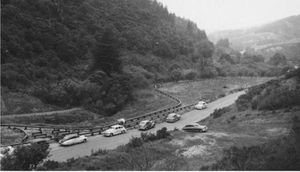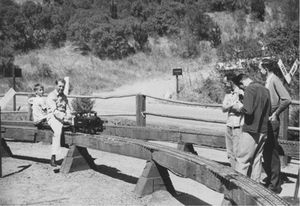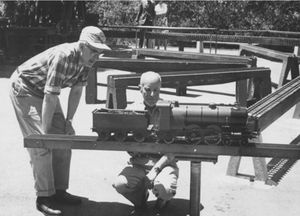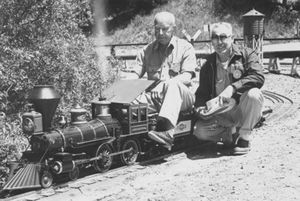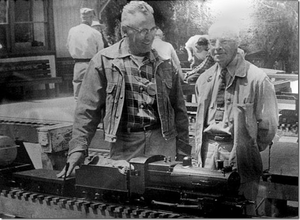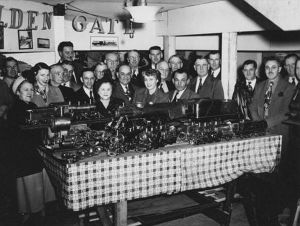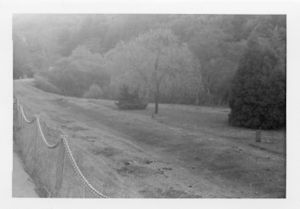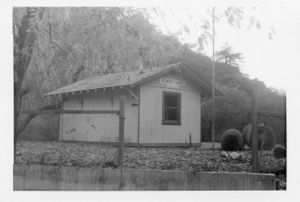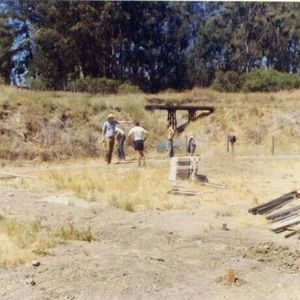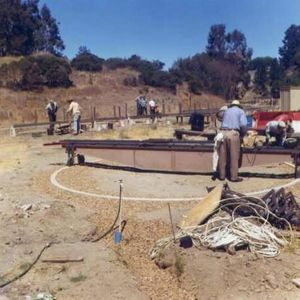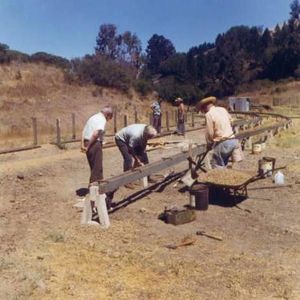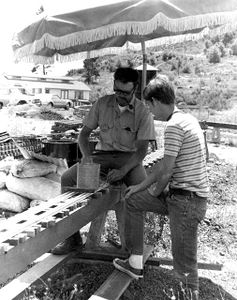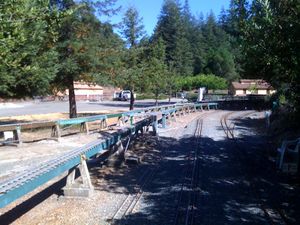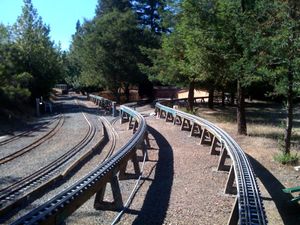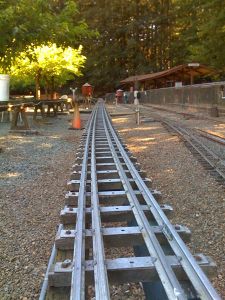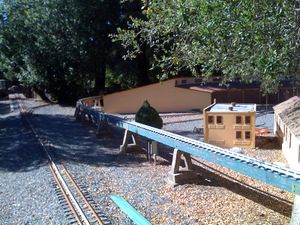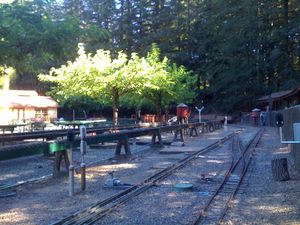Golden Gate Live Steamers: Difference between revisions
| Line 107: | Line 107: | ||
* Ransome Company Asphalt | * Ransome Company Asphalt | ||
* Liston O. Allen SP Legal Dept. | * Liston O. Allen SP Legal Dept. | ||
=== Abandonment === | |||
In 1971, the Golden Gate Live Steamers abandoned their long time site in Oakland's Redwood Regional Park, stripped the place clean (almost) and moved to their current site in Berkeley's Tilden Regional Park. It was a very sad occasion after so many happy times since GGLS moved into Redwood in 1948. | |||
My wife feels it broke my grandfather's heart after seeing the project disappear after putting so much personal effort into getting it created to begin with. | |||
<gallery widths="300px" heights="300px> | |||
File:RedwoodRegionalPark 1971 abandoned 1.jpg|Redwood Regional Park in 1971 after abandonment. Taken from the adjoining roadway, at the North end of the layout area, looking back toward the station building and "firing-up" tracks. Photo by Harry Dixon. | |||
File:RedwoodRegionalPark 1971 abandoned 2.jpg|Turning around looking North at the far curve and the picnic area beyond. At this point, the elevated track was on the raised berm in front of that big bush and the ground track was on the raised area closer to the roadway. | |||
File:RedwoodRegionalPark 1971 abandoned 3.jpg|A lonely and forgotten depot with an empty flagpole waits for the trains that will never come. The open area in the fence line with the concrete wall, is where members and visitors would back their car or trailer up to, and unload their locomotives. The plans for the depot were provided by the late rail historian and author, Capt. Fredric Shaw. Early GGLS member "Bill Smith" supervised its construction. Money for the depot construction came from the proceeds of the great "Model Engineering Show" of May-1955 held in the Oakland Auditorium. | |||
File:RedwoodRegionalPark 1971 abandoned 4.jpg|All of the firing-up tracks and related items have been removed. So MANY happy times were held in this location. I was about THREE years old when I stood right here with my Grandpa. I'm sure you would never recognize the area today! | |||
</gallery> | |||
== Tilden Park == | == Tilden Park == | ||
Revision as of 15:54, 19 August 2013
The Golden Gate Live Steamers is a club based in the Oakland/San Francisco area which promotes the live steam hobby. It is the oldest such club in the United States, having been formed in 1936 by Victor Shattock, though at that time the club had no outdoor track and steam operations were confined to the basement of Shattock's home in Oakland, California. The first GGLS outdoor track was built after 1940 at club member Loren Thacker's home in Stockton, California.
History
- “VIC SHATTOCK HISTORY TALK”
- Presented to members of the Golden Gate Live Steamers
- Regular Monthly Meeting
- Laurel Elementary School Auditorium
- Oakland, CA
- circa 1960
The Golden Gate Live Steamers started in the basement of our home. You might wonder why in the basement ? Well, going further back, like all boys I was fascinated by steam railroads so much that I was determined to build a railroad of my own.
I had a number of railroads long before I built the one in my basement, and during WWI, I built a 2-foot gauge railroad in France. It became a regular target of the Germans thus making it very uncomfortable for us. So I got all this railroad work.
After the war, I came down from Canada and went to work for the Southern Pacific. Later, we built a railroad at U.C.-Davis for their big Spring Festival one April. They arranged through my employer, S.P., to go there. Their carpenters would build the runway, I’d lay the track and we would run the trains. They estimated that over 10,000 people saw the operating exhibit. So much for my accomplishments.
Every time we moved I looked around the house for a place to establish a railroad. Finally, in 1934, we found a nice house with a large basement some 32 x 45 feet in size. Ideal, as there was nothing else in the basement except for the furnace and laundry tubs. For the next five years we were requested so many times to display our trains or put them where people could ride them. So many were attracted to that basement that after several demonstrations, many got the yen to build their own locomotives. A number of them did !
The track ran all the way around the basement with two or three sets of rails and a turntable near the furnace. There was a model of a 110-foot electrically operated turntable. Being no electrician, I got a couple of my sons to help me in that direction. There was a double slip switch in the Yard area. At the time, I had three or four engines. The water tank was near the turntable which I also used as a firing up track. A blower fastened to the stack of the locomotive sent the fumes up the chimney. First thing we did was to have a test run as soon as the first engine was fired up, then we would hook up a freight train and let it take off. Sometimes a single engine and sometimes a double-header. The track was in the basement for some twenty-seven years when the property was sold and the house had to be torn down. I sold the track to someone who is still using it now. He said it went together perfectly. We had a lot of visitors to the track, some curious and some downright interested in the “hows and wherefores” of building them and locating raw materials. Naturally, they thought that kits might be available. The press was attracted to this new thing, running live steam engines in the basement of a house. Editors were fascinated and the concept of scenic steam trains in the basement of a house prompted them to write it up. From all this publicity we got many visitors, and the most frequently asked question was: “How do you get started?” “Where do you get your kits?” Two or three of us then and there decided to start a club and get the information to everyone.
This changed our concept from a scenic indoor railroad to an operating outdoor railroad. We wanted to get some land to operate on and ride our engines. We catered to influential people whenever possible. We put on a show in the Auditorium and for the Southern Pacific and the Yardmaster’s Association who wanted something unusual. It was put on at 74th Avenue for the Storekeepers there. Moving benches, we built an 80-foot long track and had an engine running up and down hauling children. They queued up all the way around the block. Member ‘Larry Duggan’ wore himself out lifting kids on the riding car. This had its benefits in publicity and we developed many friends which paid off later. Eventually, we heard of a piece of land in Redwood Park. We went to look at it and it was necessary to cut away the “bullrushes” so we could lay stakes for the surveyors. I don’t remember when the yard dirt was put in but some may recall the Boy’s Clubhouse there where the steaming bays near the parking lot we use now.
Before stakes could be driven there was a tremendous amount of work that needed to be done. We had about eighteen hardy members and we would all go up and carve the weeds away until the ground was ready to use. Next operation was to fill the ground and then survey. We still had influence with the Southern Pacific who took care of that chore. Twenty-six of them, all bosses—twenty-six of them and they were all made Honorary Members of GGLS. Mr. McKinney, present here tonight, can probably remember the start, I guess. “Somebody told the SP Roadmaster, ‘here,give’em a few ties----“ . When we had the basement club the dues were ten cents a month, mostly for coffee and donuts which didn’t leave much of a kitty when we had Redwood available to us. Often in the red, so we decided to raise the dues to $ 1.00 per month, or the same as now, $ 10.00 per year. So, here we are, with land in terrible shape, and we needed money to get materials. With only eighteen members ! We turned to the basement again and it served us well. We got donations when they found we had the project going--- several threw in $ 10.00 “to help you folks out” and so on.
After entertaining some Scouts from Crockett one night, the lady in charge of them later sent us a check for $ 120.00 to help us build. Then different ones made loans because we needed cash for rails which were very expensive. Being faced with the problem of spending all the money on rails, which looked like it was necessary, we called a meeting in the basement. We got S.P. officials down there along with officials of Redwood Park. We put on a show with engines all over the place. It showed the officials what we were doing. We felt that we were advertising railroads anyway and if we could get their help, our troubles were over. Regarding those meetings, a lot of them took place during the War; not only various officials, but also the police. I don’t know why, but maybe the number of cars parked in front of the house aroused suspicion. “Wonder what all those cars are doing there?” Maybe subversive activities! Anyway, they were there. One early arriver introduced himself and said he wanted to know what we were doing there.. I invited him in and to stay for the meeting. He said he’d like that and it was not until then that he told me he was with the police department. I don’t recall if he left a donation or not, but it didn’t make any difference.
Well, we had the meeting, showing how worthy the work was that we were doing, and that it deserved their support and that any help they could give we’d be glad to have. The result was we got engineers to make contour maps, stake out the railroad, everything, so all they had to do was give it to the engineer of the Park District so those people could fill exactly to where the stakes had been driven. It was a great help, and we would up with a lovely flat piece of land. There were objections, of course, especially from the Horseman’s Association. “Why should we have all this level property?” Several complaints like that, but we had to prove ourselves. So we had meetings with discussions and decisions regarding the track and type. Most of the fellows wanted an elevated track so you could sit on a car and drive your engine. And where would we get the lumber ? I mentioned that the SP Roadmaster gave Mac McKinney and another fellow some ties. It was impossible to put anything down like that—we’d never get it done in ten years. So one day I went to the Roadmaster and asked if he could let us have about 150 ties. Good ones, not new, but usable ones. He said, “You’ve got your nerve”. There’s dozens of customers who want them badly and we won’t even give or sell to them…… I told him I wasn’t interested in their customers, that we were only interested in getting 150 ties. Then he said, “Where are we going to get 150 ties?” I told him GGLS has spies out and they have a lot of friends. SP is tearing up a “ballast deck trestle” at Cordelia and there is a boxcar in the Yard with over 200. “Where did you get that?” It makes no difference— You have the ties and we want them. “Are you going to need that many?” Yes, we will! He didn’t ask how we were going to get them to Redwood Park, but I was a foreman with two trucks at my disposal so I had them back a truck to the door of the boxcar and rolled them off. I think, too, that the Live Steamers were surprised when they arrived at Redwood one Sunday and saw that had been done. You see, we had to make piers to put the ties on.
It was finally decided to get lumber cut that way(demonstration at this point, in front of the membership, as to how lumber will be cut and placed) it would be fine for supporting the ties. Lots of lumber was kicking around the SP in various places that was 7 ½” x 17’ and 24’ … We took the lumber to a mill who wore out five band saw blades because of the sand and grit in the lumber. So we got plenty of piers and one day sent a truck with a gang to place them but I’m a little ahead of my story, as we had already laid out a 60’ circle, so it looked like we were going to have to be satisfied with that. Meanwhile, the “brain trust”, Harry Dixon as Secretary, Tim Reardon, Vice-President and I (Vic) as President, not being Satisfied with the layout as it was, started working on options, so one day we went to the park and tore up the whole circle. I might say that the Park people were not as sympathetic as they are with you folks today. They thought we were just a bunch of crazy nuts anyway. I guess they thought if it doesn’t work out, the land can be used for baseball or something.
After building toward the upper end, the fellows were getting sort of tired, but there was another thing about the ties. They were not exactly square! They had a twist in them, so it was necessary to get them flattened out. After using all sorts of tools, planes and adzes, etc., an SP man came along and said we could have a “planer” if we’d like. So we arranged for the power! We had all sorts of electric tools. Very little pick and shovel work was done. The ground there was hard as concrete. SP furnished the supplies and we got them all the way around. Next was ties for the rails. I do not know how many thousand there were (ed: 7500) but we got the Bridge & Building people at SP to cut them for us from pure Redwood. Band them, package them and deliver them to Redwood Park. So then there was the question of –all our money was gone for rail—so we were probably in debt. We needed nails to bind it all together. Good old SP had a kind heart ! I remember when we opened the track officially that one fellow told the SP Asst.General Manager (Mr.E.D.Moody) that “there’s more SP stuff here than you’d expect to find here, isn’t there?” “Oh no”, he said. “We knew you were getting it!” But we used to take everything we wanted. We put in a Transfer Table, water tank, angle iron and all that stuff all made in the SP shop at West Oakland.
Next we had to justify to the Park that they had done the right thing in letting us use the property. Only two or three of us had engines, and you’ll see a picture of one of my engines pulling a string of cars. This showed the public that there was activity going on. I believe there is a picture showing a 3 ½” gauge engine as finished. Harry Dixon took that picture. We were up and it was cold that day. Speaking of weather, when we officially opened it was as hot as hades. We just melted. Well, as time passed the track began to get used. I feel pretty sure everyone enjoyed the work that was progressing. There were not many of us, but we worked hard. Then, there was this General Manager, Dick Walpole. He wanted a log house put up for a station. So we drew up something that looked like a log house for a station. That’s how he wanted it, to conform to the rest of the Park. We dug holes, put up poles, you ought to have seen it. There are pictures. We knew it wasn’t coming to anything and were glad when it came down. There was a new Administration who let us remove it. It was an eyesore, anyway ! So there is not much to add to the basement story except many wanted to know how to start engines, so the basement meetings in my home became like ‘school’, which most of the fellows that were there wanted. When they ‘graduated’ I don’t know if they got diplomas or not, anyway it got publicity and people building engines. They got pointers and information that served them well and would not have gotten otherwise.
For my own part, I believe I got most of my information from “LBSC” articles in England. (L.Lawrence) … I read every book on this subject that I came across, and that was way back, even before LBSC’s writings. I had enough from those books so I could impart a little information that the fellows could follow. I think therefore, that the basement meetings helped a lot of them get started in the right direction. The “Live Steamers”, in 1940, went to Stockton where one of the boys had moved and, since he decided to build a track in his back garden, we helped him by putting down the rail. We used square key stock. We drilled holes and put finishing nails down through it. I wanted to take this opportunity to thank you for your interest in the birth of the Golden Gate Live Steamers. It isn’t all that we could tell you because the time from 1936 to the present would take more than a half hour to tell. One thing I’d like to say, that the track has been developed and improved so well it serves as a commendable compliment to the members and officers who had anything to do with it. Further, I congratulate them and am proud to have had a part in it and had so much a hand in starting it. It makes me feel grateful to know that it has grown as much as it has. Our finances used to be three or four dollars, now you have several thousand. Our membership was eighteen, now you have some 150 odd. There’s a lot that canbe done with enthusiasm and muscle, of course, to make it really worth while. As Harry Dixon said at the beginning of this presentation, “one of the largest Live Steam clubs in the World” . And that’s something to be proud of ! Thank you for your attention ……
(Presentation given by Victor T. Shattock --- circa 1960 ……)
Re-copied from audio tape by Kenneth V. Shattock ……(January 20, 2008)
Redwood Canyon Regional Park
The GGLS maintained a club track at Redwood Canyon Regional Park from 1951 until 1966.
Redwood Planning Committee
It Takes a Village
By Ken Shattock, May 2013
A lot of planning went into the construction for the track that was built in Oakland, CA's "Redwood Regional Park" back in 1948 for the "Golden Gate Live Steamers". There were meetings held at GGLS Club Headquarters in Vic Shattock's basement out in the Fruitvale District of East Oakland, CA.
Here is a photo of one of those meetings. I have endeavored to identify some of the "key players" to give you folks an idea of the involvement of some of these agencies:
Right Side of Pillar: (Left-to-Right)
- Paul Erbacher, Western Union
- Harry L. Dixon, GGLS Secy
- John Mac Donald, President, Board of Directors, Eastbay Regional Park District
- Thad Dickes, Pumper, Stationary Boiler Plant, Oakland Pier (SP)
Left Side, Rear Pillar: (Right-to-Left)
- Carl Nordberg, GGLS Sgt-at-Arms, SP Machinist (Lathe Operator)—System Maint-of-Way Shop, West Oakland
- Scotty Gordon, GGLS Member, SP Civil Engineer, Oakland Pier
- Walter Brown, GGLS Member, Co-Founder—Eastbay Model Engineers Society, Co-Chairman ‘Live Steam Standards Committee’—NMRA.
- Dick Walpole (tall guy) : Eastbay Regional Park District
- Vic Shattock (directly in front of Dick Walpole): GGLS Founder, SP Water Service Foreman—West Oakland, Co-Chairman ‘Live Steam Standards Committee’—NMRA, Redwood Regional Park Construction Site Manager
- Julian B. Watts, GGLS Member (short guy to right of Vic): SP Chief Dispatcher—Oakland Pier, (later on): General Supt of Motive Power—SP System
- Frank Dee, GGLS Member, Liasion Officer: GGLS//EBRPD O.M. Barlow (right of Frank Dee//between Walter & Scotty): SP Roadmaster—West Oakland
- Loris McKenney—GGLS Member (in front of Carl Nordberg), SP Liasion—Track and Roadbed Supplies for Redwood Park
- Ernie Haase, SP Bridge & Building Supervisor— (shorter guy) West Oakland
- Tim Reardon, GGLS Vice-President (directly behind Ernie), General Construction Foreman—GGLS Redwood Park Project
- E.D. Moody, SP Asst. General Manager, General Office, San Francisco
- Wes Adams (I think) (to right of Mr.Moody), Park Supervisor, Redwood Regional Park
- Larry Duggan (at far left of photo): ATSF RR, GGLS Member, Founder of GGLS Bulletin---“The Callboy” …
These were just a very FEW of the volunteers that came together with great community spirit and built a passenger hauling "Live Steam" track in the Oakland, CA hills.
I can think of three others:
- Gallagher & Burk crushed rock
- Ransome Company Asphalt
- Liston O. Allen SP Legal Dept.
Abandonment
In 1971, the Golden Gate Live Steamers abandoned their long time site in Oakland's Redwood Regional Park, stripped the place clean (almost) and moved to their current site in Berkeley's Tilden Regional Park. It was a very sad occasion after so many happy times since GGLS moved into Redwood in 1948.
My wife feels it broke my grandfather's heart after seeing the project disappear after putting so much personal effort into getting it created to begin with.
A lonely and forgotten depot with an empty flagpole waits for the trains that will never come. The open area in the fence line with the concrete wall, is where members and visitors would back their car or trailer up to, and unload their locomotives. The plans for the depot were provided by the late rail historian and author, Capt. Fredric Shaw. Early GGLS member "Bill Smith" supervised its construction. Money for the depot construction came from the proceeds of the great "Model Engineering Show" of May-1955 held in the Oakland Auditorium.
Tilden Park
High Track
Here is a small handful of photos depicting the "high track" at GGLS in Tilden Regional Park, Berkeley, CA. The track accommodates 2-1/2, 3-1/2 and 4-3/4-inch gauge locomotives. It is quite extensive and I would venture to say that GGLS could probably boast of having one of the longest stretches of 2-1/2-inch gauge track (Gauge 3) in the entire country...
Many kudos go to GGLS Life Member "Bob Morris" and his son "Robbie", assisted by a few others, who diligently re-built a large percentage of the "high track" due to rotten lumber for approximately $1792.00 !!
I thought that you "Easterners" might enjoy seeing our small scale facility. All photos by Mike Massee.
Happy Live Steaming !!
Ken Shattock
May 2013
Big Loop Ride
All of the many block signals are fully automatic and interlocked. There are remote turnout selector switches for controlling diverging routes, here and there.
I think you guys need to have a ride around and enjoy the scenery. I hope you have already purchased your tickets. Sit back, relax and enjoy your ride. Your engineer today is Junior Member "Scott Kennedy". He really knows his stuff!! Better look out, you just might take a ride over that BIG TRESTLE too.
http://www.youtube.com/watch?v=2OwnZqdfUJE
Cheers.
Ken Shattock
May 2013
Notes from Ken Shattock
- Gary Kubicek was a member of GGLS in the late 1940's and helped them build their first outdoor track in Oakland, CA's "Redwood Regional Park". He later became a charter member of LALS.
75th Anniversary Meet
Ken Shattock writes:
- On July 8, 9 and 10-2011 GGLS celebrated their 75th Anniversary at their Tilden Park site in Berkeley, CA. They are the oldest such club in the United States today. A "Special Thanks" to Bob (Postwar Bob) and Sandy Morris for co-chairing this big event along with all their helpers. The event was nostalgic too. For example, the son of one of the original members was there, the grandson of one of the original members was there, and the most amazing thing: The FIRST Secretary of GGLS was there at age 95. THAT just blew everyone away !!
- A couple of Board members of the Park District were in attendance. The lady President of the Park District and her husband attended the banquet as well and seemed to be enjoying themselves.
- Enjoy the photo story folks !
